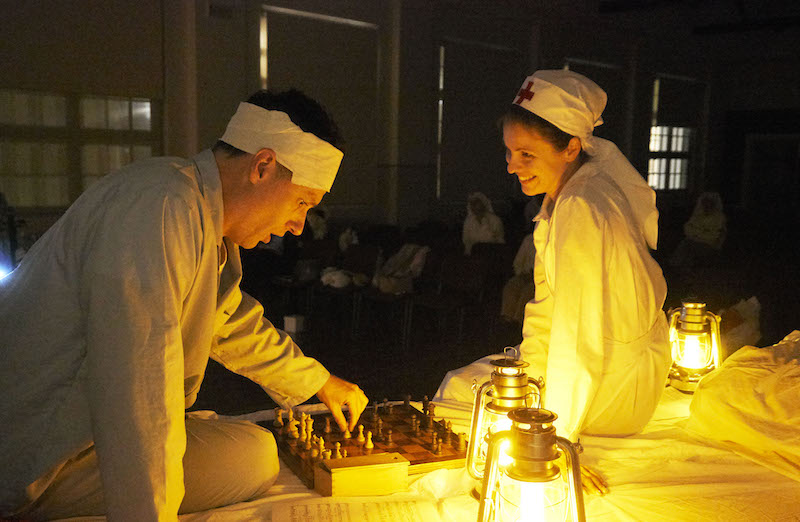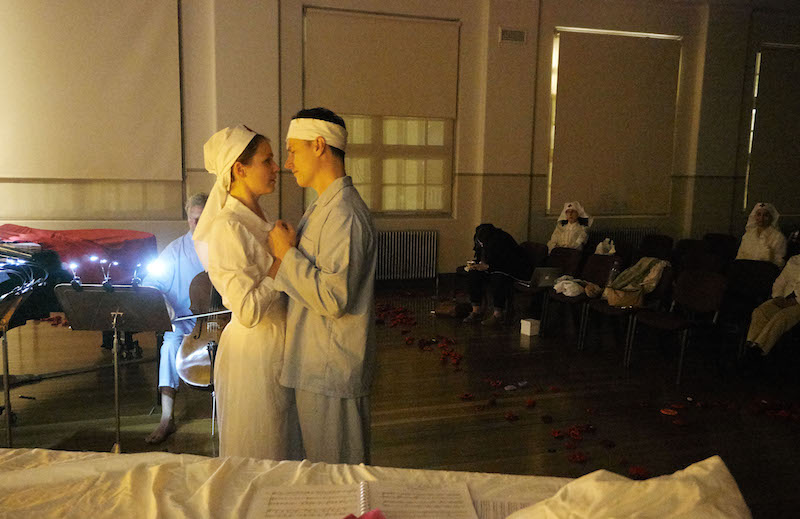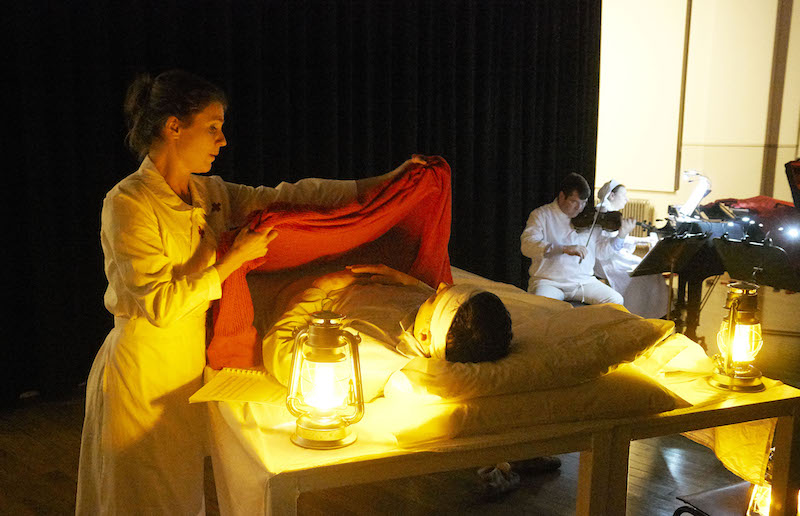The Flowers of War commemoration of the centenary of World War One continues throughout this year with its focus on France and Belgium. Several days ago I reviewed a program devoted largely to music by Debussy and Ravel, performed to the imagery of Claude Monet. This was presented in the dead acoustic of the Fairfax Theatre of the National Gallery of Australia.
The second phase of this focus on Franco-Flemish music proceeded this past week in the cathedral-like acoustic of the High Court building next door to the Gallery. The Healers was billed as “a pocket opera about the role of women in World War One, how they healed men, broken by violence, through love”. It was a promising and intriguing proposition, one whose potential impact was defeated by it presentation and execution.
 Rehearsals for The Flowers of War project The Healers. Photograph © Peter Hislop
Rehearsals for The Flowers of War project The Healers. Photograph © Peter Hislop
For this event, Christopher Latham assembled some 20 or so songs or instrumental pieces by composers who served or volunteered in the medical services, along with works by soldiers who were wounded or killed in action. Many were Australian premieres, or so it was claimed, and few lasted more than a few minutes. The performing ensemble comprised four instrumentalists (clarinet, violin, cello and piano) and two singers (a soprano and a tenor). Each was assigned a dramatic identity, and was dressed in period medical costume, and given lines to recite as their characters.
On the whole, the two young singers, Simone Riksman (The Belgian Nurse) and Andrew Goodwin (The Wounded Soldier), sang, danced and acted their roles effectively, at times even achieving genuine pathos and poignancy. Less so the instrumentalists, begging the question: can or should musicians be required to act and speak when they have little if any experience as actors or given adequate direction?
On musical grounds alone, the performances were mostly admirable. There were several revelations, notably the beauteous songs of the Boulanger sisters, Nadia and Lili. David Pereira’s performance of one of the Three Pieces for Cello and Piano by Nadia Boulanger (in six flats, we were informed!) was heart-rending. Goodwin’s impassioned delivery of Ivor Gurney’s song Sleep brought goose bumps to my skin. Caroline Almonte’s performance of E.J.Moeran’s piano solo The Lake Island delivered me to the deepest mists of Impressionism. Left on its own, the music was enough to make this a most memorable and worthwhile experience.
The dramatic element was less satisfactory. The audience was transported into a hospital ward, with a dozen nurses in white Red Cross uniforms applying bandages to imaginary wounds on some of us. (Fortunately, the several nervous Justices of the High Court sitting directly in front of me were spared this procedure.) A grand piano was draped in a crimson red blanket, positioned alongside a high hospital bed. On the floor was the signature carpet of red poppies.
 Rehearsals for The Healers. Photograph © Peter Hislop
Rehearsals for The Healers. Photograph © Peter Hislop
This setting was derived from a series of paintings and photographs contained in the detailed programme booklet. Those images provided the basis – and, indeed, inspiration – for the series of dramatic tableaux from which the form of the presentation was constructed. A kind of narrative was sewn together from these images and from the music Latham had assembled. Unfortunately, the spoken lines too often descended into the banal and embarrassing. “I am so tired of this war,” Latham announced, in the role of a Medical Orderly. “My heart is filled with tears.”
Mysteriously, but mercifully, the spoken lines fell silent about half-way through the presentation. From that point, the music carried most of the emotion. Could there have been some other way of delivering the same context? My mind went back to works with solo narrators and ensembles of singers/musicians who hover outside the main action, back to Monteverdi’s Il combattimento through to various works like Stravinsky, notably L’histoire du soldat. The addition of two experienced actor-narrators would have greatly benefited this presentation. Admittedly, at the same time, it would have inflated its cash-strapped budget significantly.
There was a single tableau which created a poignant moment that will live long in the memory. Maurice Jaspart was a real-life clarinet student from the Paris Conservatoire who lost his arm in an explosion. In this presentation, he laments the reality that he will never play the instrument again. A Red Cross nurse brings him a clarinet and places it in his left arm. “I will be your right arm,” she says. He puts his lips to the reed and negotiates some of the keys with his left arm. With her right hand, the Nurse plays the keys he cannot play. In that one moment, clarinettists Tom Azoury and Catherine McCorkill, a recent member of the Australia Ensemble, became one For those few minutes, time seemed to stop as they negotiated the elegant Pastoral of Arthur Bliss. There was hardly a dry eye in the house.
 Rehearsals for The Healers. Photograph © Peter Hislop
Rehearsals for The Healers. Photograph © Peter Hislop
A practised dramatist cum stage director could have created more such moments, and delivered a more coherent and persuasive dramatic shape. Latham does admirable and uniquely valuable work in researching the music and creating the concept and context of these programs. He is, in effect, their curator-dramaturg. One man alone cannot be expected to conceive ‘a pocket opera’ (or dramatic scena, as this was), write its script, rehearse its performers (their spoken lines, even their mimes and waltzes!), devise a lighting plot, assemble costumes and props, as well as play the violin in the ensemble. Not to mention the ancillaries: write and produce the printed programme, assemble an army of volunteers, and undertake most of the publicity. This sort of complex enterprise needs another dimension.. An external set of eyes and ears may even have found a place for a dash of dark humour (echoes of the 1969 musical film Oh! What a Lovely War). As it was, the gloom and doom, the grief and unrelenting sorrow were almost over-powering and self-defeating.
Latham’s vision is most beautifully expounded in the essays contained in his generous and often elaborate programme booklets. Let us hope that the Flowers of War project, auspiced by the Australian War Memorial, manages to publish a proper illustrated volume of his painstaking research.
In effect, this presentation emerged as a kind of workshop, a ‘work in progress’ that has yet to achieve its true potential and promise.
Over the coming week, this same programme, with a largely different cast, will be presented in several locations in France, ending with a performance at Sint-Jans College, in Vlaanderen, Belgium on Thursday, October 19.











Comments
Log in to join the conversation.